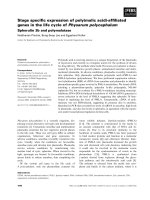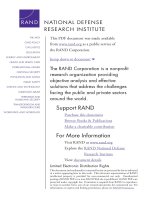The Steps of the Troubleshooting Cycle
Bạn đang xem bản rút gọn của tài liệu. Xem và tải ngay bản đầy đủ của tài liệu tại đây (13.63 KB, 4 trang )
1 - 4 IT Essentials I v2.0 - Lab 12.1.7 Copyright 2002, Cisco Systems, Inc.
Lab 12.1.7: The Steps of the Troubleshooting Cycle
Estimated Time: 25 Minutes
Objective
Upon completion of this lab, the student will be able to describe the importance of, and
identify the steps involved in, the troubleshooting cycle.
Equipment
This is a written lab. No equipment is necessary.
Scenario
The student has just started a new job, as a computer technician, with a small consulting
group. The company has approximately 50 employees with varying levels of computer
expertise. As a computer technician, the student’s primary responsibility is to provide
desktop support to these employees.
The student has recently gone through job orientation and has received training on the
procedures for responding to computer problems. The training included an introduction to
the hardware and software in use, common errors, common symptoms, and using the
troubleshooting cycle to effectively solve problems.
The end user is complaining that their computer has stopped responding. It is the
student’s responsibility to troubleshoot and resolve this problem.
Procedures
The troubleshooting steps can be very useful in solving computer problems. Sometimes a
problem will require common sense and the solution is straightforward. Other times, the
solution will require a broad level of technical knowledge. In this lab, the student will
follow the troubleshooting cycle as an example of solving computer problems. The lab will
begin with step one, which is identifying the problem from the end user.
Step 1
After arriving on scene, begin the troubleshooting cycle by defining the problem. Start by
identifying the general symptoms and then determine the possible causes for the existing
problem.
For future references, the student has brought along a notebook to document the
findings.
Upon arrival, what environmental factors can be assessed? How is an assessment of the
environment beneficial?
__________________________________________________________________
__________________________________________________________________
Step 2
The next step is to gather pertinent information from the end user. Initially, ask general
2 - 4 IT Essentials I v2.0 - Lab 12.1.7 Copyright 2002, Cisco Systems, Inc.
questions with the goal of obtaining a broad idea about the computer problem. Questions
should gain focus as information is obtained from the end user.
What questions could be asked to obtain a broad idea about the problem?
__________________________________________________________________
__________________________________________________________________
After questioning, it is learned that the computer is not producing any sound. Everything
else appears to be functioning correctly.
The student can now assume the problem is related to the multimedia (sound)
capabilities of the computer. What questions could be asked or actions taken to better
define the problem?
__________________________________________________________________
__________________________________________________________________
During questioning, it is determined that the end user has been having problems ever
since a recent sound card upgrade. The student attempts to reproduce the error by
playing an audio file. Sure enough, the audio file does not produce any sound. The
student inspects the audio player and it appears to function correctly. Then, the student
visually inspects speaker cables and verify that the speakers are turned on. The student
sees no apparent problems with the connected devices and the speakers are turned on.
Gathering information is by far the most important step of the troubleshooting cycle.
Step 3
Given the above scenario, what are the most likely causes of the malfunctioning
soundcard?
__________________________________________________________________
__________________________________________________________________
The user has stated that he is having problems producing sound from his machine and
there has been a recent upgrade performed on his soundcard. From this information, you
can infer the problem is related to the recent upgrade of the sound card.
It has also been verified that both the audio player and speakers are functioning properly.
You have also verified the speakers are connected correctly. Since you have verified the
speakers and audio player are working, you figure it is unlikely they are causing the
problem. You continue the troubleshooting cycle by creating solutions for the apparently
bad sound card installation.
Step 4
Effectively developing a solution involves gathering correct information, knowledge of the
computer components, and the ability to recognize symptoms.
The problem has been isolated to a bad installation of the sound card.
3 - 4 IT Essentials I v2.0 - Lab 12.1.7 Copyright 2002, Cisco Systems, Inc.
Give an example of a solution that might solve this user’s problem:
__________________________________________________________________
__________________________________________________________________
The solution should focus around the different aspects of the sound card installation.
Based on experience, you are aware that most sound card problems result from a bad or
outdated driver, improperly installed sound card, or system resource conflicts.
For example, one solution might be verifying the proper installation of the sound card in
the PCI slot. If the problem still exists, check for system resource conflicts. Finally, update
or reinstall the driver.
Step 5
The first aspect of the solution involves simply checking the installation of the soundcard.
What precautions need to be taken before working inside the computer case?
__________________________________________________________________
__________________________________________________________________
You verify the soundcard has been properly inserted and has good connections. It
appears to be properly inserted. Experience has told you to check for obvious solutions
first. If the problem still exists, move onto the second aspect of the solution, which is to
check if there are any system resource conflicts.
The user is running Windows 98 and you check resource conflicts in the Device
Manager.
In the Device Manager for Windows 98, what will indicate a system resource conflict?
__________________________________________________________________
__________________________________________________________________
You do not notice any problems and move on to updating or installing the device driver
for the sound card. In order to get the latest device driver for the sound card, you visit the
website for the sound card manufacturer. You conduct a search for the sound card driver
and locate a new driver. This driver is different from the one the user installed because it
includes a Windows 98 patch that resolves known compatibility issues. You install the
new driver and then reboot the machine.
Step 6
The fifth step is determining if the problem has been solved. If the problem appears to be
solved, than the troubleshooting process has been successfully completed. If the problem
is not fixed, than you will be required to return to previous steps and continue the
troubleshooting process. Sometimes, it might be necessary to undo changes made to the
system and revert to the old configuration. In either case, be certain to properly document
the results. Documenting your results will help you work more productively in the future.
After boot-up, play an audio file and hear sound out of the speakers. The problem has
4 - 4 IT Essentials I v2.0 - Lab 12.1.7 Copyright 2002, Cisco Systems, Inc.
been resolved and the troubleshooting cycle has come to an end.
Troubleshooting
What are the steps in the troubleshooting cycle?
Step 1 -
___________________________________________________________
Step 2 -
___________________________________________________________
Step 3 -
___________________________________________________________
Step 4 -
___________________________________________________________
Step 5 -
___________________________________________________________
Step 6 -
___________________________________________________________
Reflection
It has been stated that troubleshooting is cyclical. What does this mean?
__________________________________________________________________
__________________________________________________________________
Why are the steps in the troubleshooting cycle useful for solving computer problems?
__________________________________________________________________
__________________________________________________________________
What is the most important step in the troubleshooting cycle, and why is it so important?
__________________________________________________________________
__________________________________________________________________
If the problem exists after the solution has been implemented what steps should be
taken?
__________________________________________________________________
__________________________________________________________________









